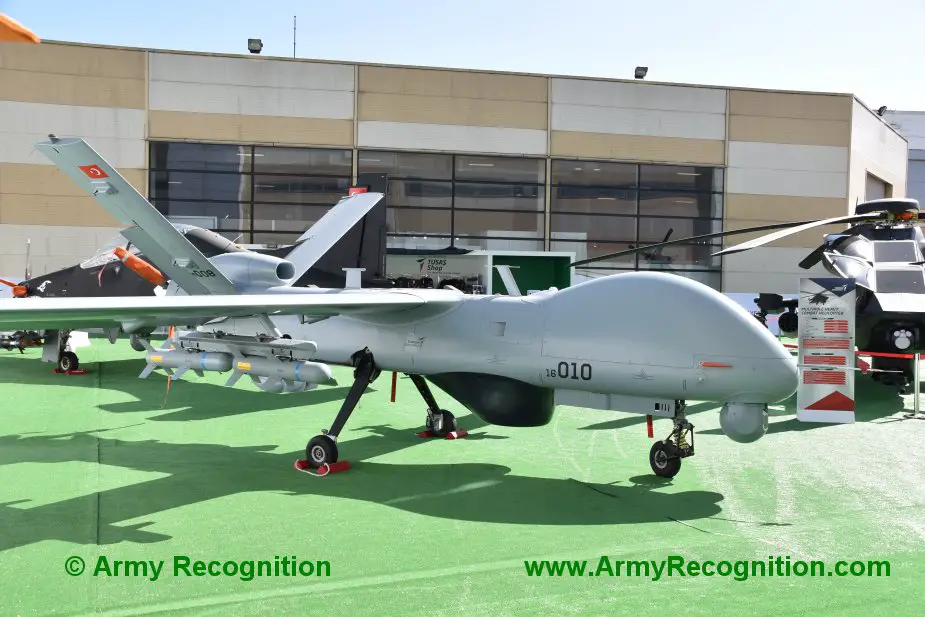In Syria, Turkish-made armed drones like the Bayraktar TB2 and Anka in the Idlib area have made the army much more effective on the battlefield against the Syrian army. Hence a new doctrine is being formulated for this kind of war instrument.

Turkish-made Anka armed drone displayed at IDEF 2019 (Picture source: Army Recognition)
Turkey’s extensive deployment of armed drones has caught off guard and struck hard Syrian regime forces in and around northwestern Syria, just across from Turkey's southern border. These Turkish-made armed drones hitting and destroying everything from tanks and air missile defense systems to howitzers as well as military bases and chemical warfare depots demonstrate the efficiency of such a device. Deployed homegrown drones, Bayraktar TB2, developed by Turkey’s leading unmanned aerial platform developer Baykar Makina, and ANKA, produced by Turkish Aerospace Industries (TAI), have given Turkey a vital edge in the field and mark the culmination of years of investment and evolution for Turkey, whose military has become one of the most experienced users of drones. They have become a symbol of national pride as the country seeks to shed its reliance on outside powers and become a leading defense exporter.
The capabilities of Turkey’s drone fleet have been proven in combat with a recent series of strikes against the Syrian regime supported by Russia. Turkey’s decision to send a mass-coordinated unmanned-aerial-vehicle (UAV) attack points to its availability of options. Turkey is now able to gather key intelligence on Syrian air defenses, especially those that managed to down Turkish UAVs: at least seven Turkish drones were targeted by Syrian air defense systems, but the drones were reportedly still able to strike their targets.
Turkey for the past ten years has been developing its national industrial capacity of UAVs. The newspaper emphasized that Turkey's army could carry on operations without the support of the Russians due to its capabilities in electronic warfare.
Turkey’s extensive deployment of armed drones in its fight against Syrian regime forces has put forward a "new military doctrine in the world. "For the first time in the world, drones were used as the primary element in airstrikes during Turkey's Operation Spring Shield," said Bahri Mert Demirel, a defense industry expert in Turkey. The use of drones in this manner "has put forward a new military doctrine not only in Turkey but also in the world's literature on warfare," he told Anadolu Agency (AA) on Thursday. Speaking on the purpose of using drones on the battlefield, Demirel said in general, UAVs are intended to be used as close air support. Apart from this, they are used to gather electronic and signal intelligence and are also deployed as a support element for other air force elements, added Demirel, who has authored several research papers on the defense industry. Turkish forces have neutralized 3,138 regime elements in Syria since the start of Operation Spring Shield and destroyed 151 tanks, 47 howitzers, 3 jets, 8 helicopters, 3 drones and 8 air defense systems, according to the Turkish Defense Ministry.
Demirel also underlined that Turkey's electronic warfare systems have played a vital role in allowing Turkish armed drones to destroy Syrian air defense systems despite Idlib's airspace being closed. Among a large amount of video footage, including a series of those posted on Twitter by the Defense Ministry, showing Turkish drone strikes targeting a range of regime assets, the one showing an ANKA armed drone striking an apparently active Russian-made Panstir S-1 air defense system deployed inside Idlib went viral on social media: the clip shows Pantsir S-1 sitting placidly as the MAM-L smart ammunition projectile, developed by leading defense company Roketsan and fired from ANKA, barrels toward it. The apparently active system failed to detect the incoming missile or possibly the drone that was flying over the range of the radar.
Turkey has the most extensive operational capabilities and experience in the use of drones among European countries.















